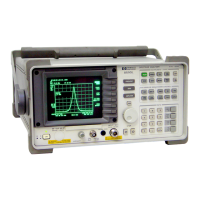624 Chapter12
RF Section
A15 RF Assembly
b. For maximum gain (flatness data equals 0), RF GAIN (A15U909
pin 10) should be at approximately 0 Vdc and the current through
each attenuator section should be close to 0 mA.
CAUTION As long as the flatness data just entered is not stored, the
previously-stored flatness data will be present after the power is cycled.
14.Move the WR PROT/WR ENA jumper on the A2 controller assembly
to the WR PROT position.
15.Reconnect the cable to A15J801.
Flatness Compensation Control
Refer to function block G on A15 RF Section Schematic Diagram in the
8560 E-Series Spectrum Analyzer Component Level Information.
The Flatness Compensation Control consists of a buffer amp (U909C)
and two identical voltage-to-current converters (U909B and U909D).
The thermistor RT901 in the buffer amp provides temperature
compensation for the PIN diodes in the gain stages and the SAW filters.
PIN Switch Drivers
Refer to function block H on A15 RF Section Schematic Diagram in the
8560 E-Series Spectrum Analyzer Component Level Information.
The control latches control the PIN Switch Drivers illustrated in
Function Block I.
1. Connect the positive lead of a DVM to A15J901 pin 15 (HEXTMIX).
Connect the negative lead to A15J901 pin 6. The measured signal
controls the switching between internal and external IF signals.
2. On the spectrum analyzer, press
AUX CTRL and EXTERNAL MIXER.
The voltage on the DVMshould measure approximately +5 Vdc (TTL
high).
3. On the spectrum analyzer, press
AUX CTRL and INTERNAL MIXER.
The voltage on the DVM should measure approximately 0 Vdc (TTL
low).
4. Connect the DVM positive lead to A15J901 pin 13 (LSID). The signal
measured turns on the SIG ID oscillator.
5. On the spectrum analyzer, press
SIG ID ON (if present), SGL SWP.
6. Subsequent pushes of
SGL SWP should cause the signal measured on
the DVM to toggle between TTL high and low levels.
7. Connect an oscilloscope probe to A15U902 pin 7 (LRDIR) and the
probe ground lead to A15J901 pin 6. The signal measured controls
the flatness compensation circuit.

